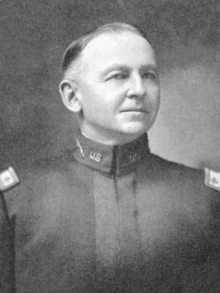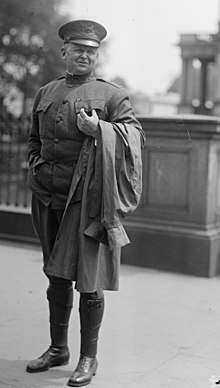Joseph Compton Castner
Joseph Compton Castner (November 18, 1869 - July 8, 1946) was a United States Army general. Castner commanded the Ninth Infantry Brigade in all its operations as a part of the Fifth Division, American Expeditionary Forces.
Joseph Compton Castner | |
|---|---|
 Brigadier General Joseph C. Castner, Commanding the Ninth Infantry Brigade from May 10, 1918 | |
| Born | November 18, 1869 New Brunswick, New Jersey |
| Died | July 8, 1946 (aged 76) |
| Service/ | United States Army |
| Rank | Major general |
Early years
He was born in New Brunswick, New Jersey, November 18th, 1869.[1] His father, Cornelius W. Castner, served as captain of one of New Brunswick's first companies in the American Civil War.[2] In 1891, Castner graduated from Rutgers College (now Rutgers University ) with a degree in Civil Engineering.
Career

On August 1, 1891, he was commissioned Second Lieutenant in the United States Army and assigned to the Fourth Infantry for duty. He was subsequently promoted as follows: First Lieutenant, Fourth Infantry, April 28, 1898; Captain, Squadron Philippine Cavalry, April 23, 1900; Captain, Fourth Infantry, February 2, 1901; Major, Twenty-first Infantry, August 27, 1913; Lieutenant Colonel, Sixth Infantry, May 13, 1917; Colonel, Thirty-eighth Infantry, August 5, 1917; Brigadier General, Ninth Brigade, April 12, 1918. He attended the Infantry and Cavalry School in 1895, and was in the War College in 1915.[3]
Prior to World War I, Castner had already distinguished himself. While a Lieutenant, he participated as an explorer in the Glenn Expedition in Alaska.[4] In the Philippines, for his services with the Tagalog Scouts, he was promoted to a Captaincy in the Philippine Squadron of Cavalry, which commission he held until receiving a captaincy in the Regular Army. Later, he served as Constructing Quartermaster in both Honolulu and in Yellowstone National Park. While yet a Captain, he commanded the Second Battalion, Fourteenth Infantry, and under his training that battalion made an unequaled record in known distance firing. While a Major, he was Adjutant General of the District of Columbia Army National Guard, which he developed to a high state of efficiency. As Colonel of the Thirty-eighth Infantry, he instilled that fighting spirit which won for that regiment its fame as the "Rock of the Marne."[3]
As Brigadier General, he took command of the Ninth Infantry Brigade. In the quiet Anould and St. Die sectors, he gave the units of the Brigade effective training for the big operations that were to follow. In the Battle of Saint-Mihiel, General Castner's brigade was at first in reserve with the Tenth Brigade in line. When passage of lines was made, he pushed his outpost lines up near to the Hindenburg Line. In the first phase of the Meuse-Argonne Offensive, his Brigade captured Cunel and drove the enemy from the Bois-de-la-Pultiere and the northwestern Bois-de-Foret. In the second phase of the Meuse-Argonne Offensive, Castner's Brigade captured Aincreville, Clery-le-Grand, Clery-le-Petit, Bois de Babiemont, the Punchbowl and Doulcon. Then the Brigade forced the difficult crossing of the river Meuse and fighting northward captured in succession Dun-sur-Meuse, Milly-devant-Dun, Lion-devant-Dun, Cote St. Germain, Château de Charmois, Mouzay, and the Foret de Woevre.[3]
In appreciation for his services in the Meuse-Argonne Operation, Castner was awarded the Distinguished Service Medal.[5]
He was cited in Fifth Division Orders. While his brigade formed part of the Army of Occupation, Castner took the course of instruction at the Army Center of Artillery Studies at Trier, Germany.[3]
Castner retired while commanding Third Division in the Western States.
Death and legacy
He died on July 8, 1946.[4][6] He was buried at San Francisco National Cemetery.
Mount Castner, which is named in his honor, is located in the area of Alaska that he explored in 1898.[7]
Further reading
- Moomjian, Scott Avedis (1993), "Roaring Joe": The Life of Major General Joseph Compton Castner, 1869-1946
References

- Davis, Jr., Henry Blaine (1998). Generals in Khaki. Pentland Press, Inc. p. 70. ISBN 1571970886. OCLC 40298151.
- Wall, John Patrick; Pickersgill, Harold E. (1921). History of Middlesex County, New Jersey, 1664-1920 (Public domain ed.). Lewis historical publishing Company, Incorporated. pp. 357–.
- Stevenson, Kenyon (1919). The official history of the Fifth division, U. S. A.: during the period of its organization and of its operations in the European world war, 1917-1919. The Red diamond (Meuse) division (Public domain ed.). The Society of the Fifth division. pp. 23–.
- "Castner Collection" (PDF). Anchorage Museum. 29 June 1991. Retrieved 21 October 2014.
- "Valor awards for Joseph Compton Castner".
- Davis, Jr., Henry Blaine (1998). Generals in Khaki. Pentland Press, Inc. p. 70. ISBN 1571970886. OCLC 40298151.
- "Mount Castner". Geographic Names Information System. United States Geological Survey. Retrieved 2020-03-12.